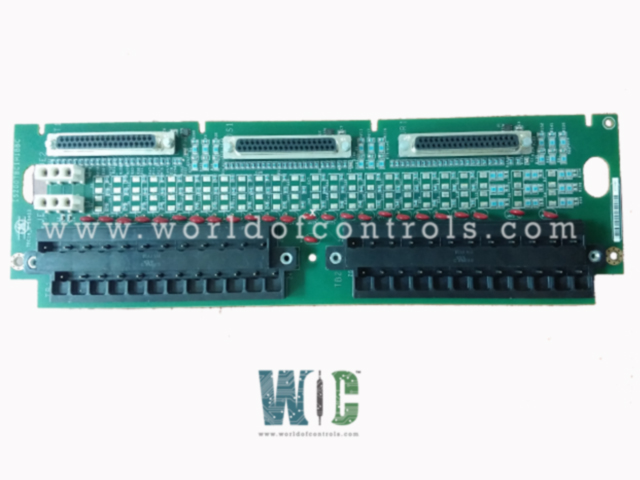SPECIFICATIONS
Part No.: IS200TBCIH1BCE
Manufacturer: General Electric
Country of Manufacture: United States of America (USA)
Size: 13.0 in. x 4.0 in
Temperature Operating: -30 to 65oC
Product Type: Contact Terminal Board
Availability: In Stock
Series: Mark VI
Functional Description
IS200TBCIH1BCE is a Contact Terminal Board developed by GE. It is a part of Mark VI excitation system. The Contact Input Terminal Board (TBCI) serves a specific function within the system architecture, facilitating the management of multiple dry contact inputs. It is a crucial interface, managing a considerable number of dry contact inputs by providing a structured and organized terminal arrangement. Its design, equipped with noise suppression circuitry and a dedicated DC power supply, ensures reliable and protected reception and handling of signals within the system. This comprehensive functional description highlights the key role played by the Contact Input Terminal Board (TBCI) in handling multiple contact inputs while ensuring operational reliability through power supply configuration and noise suppression measures.
Contact Input Handling
- Designed to accommodate 24 dry contact inputs, arranged and connected through two barrier type terminal blocks.
- These inputs serve as triggers or signals received from external devices or sources, typically in the form of open or closed circuits.
Power Supply Configuration
- DC power is specifically wired into the TBCI to facilitate contact excitation.
- This power supply is essential for activating and managing the contact inputs, ensuring proper functionality and responsiveness of the system.
Noise Suppression Circuitry
- To enhance operational reliability and protection against external interference, the contact inputs incorporated into the TBCI are equipped with noise suppression circuitry. These circuits are essential in safeguarding against surges and high-frequency noise that could potentially affect the integrity or accuracy of the received signals.
Surge and Noise Protection
- The presence of noise suppression circuitry within the TBCI is critical, as it aids in mitigating the adverse effects caused by sudden electrical surges or high-frequency disturbances.
- This protection ensures the accuracy and stability of the received signals, preventing false triggers or misinterpretation of input data.
Input Filter and Power Consumption
- Input Filter: The hardware filter integrated into the board operates with a duration of 4 milliseconds, reducing high-frequency noise and suppressing surges.
- Power Consumption: The terminal board consumes approximately 20.6 watts during its operation.
Temperature Rating and Fault Detection
- Temperature Rating: The operational temperature range for the board is specified between 0 to 60 degrees Celsius.
- Fault Detection: The board is equipped with fault detection mechanisms that include identifying loss of contact input excitation voltage, non-responsive contact input in test mode, and unplugged cables.
Number of Channels and Contact Input Configuration
- The board features a total of 24 contact voltage input channels, enabling the handling of multiple input signals.
Operation and Signal Processing
- Signal Filtering and Surge Suppression: Filters are employed to reduce high-frequency noise and prevent surges at each input point, ensuring signal integrity near the entry point.
- Power Supply for Contact Inputs: Dry contact inputs on H1 are powered by a floating 125 V DC supply (with a range of 100-145 V DC) sourced from the turbine control.
- Signal Transmission and Isolation: Discrete input voltage signals are transmitted to the I/O processor, passing through optical isolators. These isolators provide group isolation, ensuring signal integrity, and transfer the signals to the system controller.
- Threshold Setting and Signal Tracking: The isolation circuit's reference voltage sets a transition threshold at 50% of the applied floating power supply voltage. The tracking is clamped not to fall below 13% of the nominal rated supply voltage. This action ensures that all contacts indicate 'open' when the voltage dips below this predefined level.
The WOC team is always available to help you with your Mark VI requirements. For more information, please contact WOC.
Frequently Asked Questions
What is IS200TBCIH1BCE?
It is a Contact Terminal Board developed by GE under the Mark VI series.
What is the power consumption during operation?
The terminal board consumes approximately 20.6 watts while functioning within the system.
What is the temperature range in which the TBCI operates?
The board operates reliably within a temperature range of 0 to 60 degrees Celsius, providing functionality across varied environmental conditions.
What fault detection mechanisms are incorporated?
The board features fault detection for loss of contact input excitation voltage, identification of non-responding contact inputs in test mode, and detection of unplugged cables.
How many contact voltage input channels does the TBCI support?
Contact Input Terminal Board accommodates a total of 24 contact voltage input channels, enabling the handling of multiple input signals.
